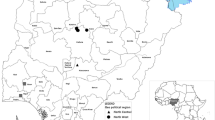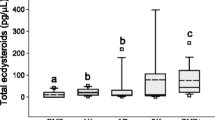Abstract
The composition of the five-component honey bee queen mandibular gland pheromone (QMP) of mated European honey bee queens was compared to those of virgin and drone-laying (i.e., laying only haploid unfertilized eggs that develop into males), European queens and Africanized mated queens. QMP of mated European queens showed significantly greater quantities of individual components than all queen types compared, except for a significantly greater quantity of 9-hydroxy-(E)-2-decenoic acid (9-HDA) found in Africanized queens. Glands of European drone-laying queens contained quantities intermediate between virgin and mated queens, reflecting their intermediate reproductive state and age. QMP ontogeny shifts from a high proportion of 9-keto-(E)-2-decenoic acid (ODA) in young unmated queens to roughly equal proportions of ODA and 9-HDA in mated queens. A biosynthetic shift occurs after mating that results in a greater proportion of 9-HDA, methylp-hydroxybenzoate (HOB), and 4-hydroxy-3-methoxyphenylethanol (HVA) production, accompanied by a decreased proportion of ODA. Africanized QMP proportions of ODA and 9-HDA were significantly different from European queens. A quantitative definition of a “queen equivalent” of QMP is proposed for the various queen types, and a standard queen equivalent for mated European honeybee queen mandibular gland pheromone is adopted as 200µg ODA, 80µg 9-HDA, 20µg HOB, and 2 µg HVA.
Similar content being viewed by others
References
Allsopp, M. H. 1988. Mandibular gland acids and laying workers in African honey bees, pp. 72–79,in G. R. Needham, R. E. Page, M. Delfinado-Baker, and C. E. Bowman (eds.). Africanized Honey Bees and Bee Mites. Ellis Horwood Ltd., Chichester.
Conover, W. J. 1980. Practical Nonparametric Statistics, 2nd ed. J. Wiley & Sons, Toronto.
Currie, R. W., Winston, M. L., Slessor, K. N., andMayer, D. F. 1992a. Effect of synthetic queen mandibular gland pheromone sprays on pollination of fruit crops by honey bees (Apis mellifera L. Hymenoptera: Apidae).J. Econ. Entomol. 85:1293–1299.
Currie, R. W., Winston, M. L., andSlessor, K. N. 1992b. Effect of synthetic queen mandibular gland pheromone on honey bee (Apis mellifera L. Hymenoptera: Apidae) pollination of berry crops.J. Econ. Entomol. 85:1300–1306.
Crewe, R. M. 1982. Compositional variability: The key to social signals produced by the honeybee mandibular glands, pp. 318–325,in M. D. Breed, G. D. Michener, and H. E. Evans (eds.). The Biology of Social Insects. Westview Press, London.
Crewe, R. M., andVelthuis, H. M. W. 1980. False queens: A consequence of mandibular gland signals in worker honeybees.Naturwissenschaften 67:467–469.
Daly, H. V., andBalling, S. S. 1978. Identification of Africanized honey bees in the Western hemisphere by discriminant analysis.J. Kans. Entomol. Soc. 51:857–869.
Gast, von R. 1967. Untersuchungen über den Einfluss der Königinnernsubstanz auf die Entwicklung der endokrinen Drüsen bei der Arbeiterin der Honigbiene (Apis mellifica).Insectes Soc. 14:1–12.
Hildebrandt, H. H., andKaatz, H. H. 1990. Impact of queen pheromone on the physiological status of worker honey bees (Apis mellifera L.), pp. 740–741,in G. K. Veeresh, B. Mallick, and C. A. Viraktamath (eds.). Proceedings of the 11th International Congress of the I.U.S.S.I., Bangalore, India.
Kaatz, H. H., Hildebrandt, H. H., andEngels, W. 1992. Primer effect of queen pheromone on juvenile hormone biosynthesis in adult worker honey bees.J. Comp. Physiol. B. 162:588–592.
Kaminski, L.-A., Slessor, K. N., Winston, M. L., Hay, N. W., andBorden, J. H. 1990. Honey bee response to queen mandibular pheromone in a laboratory bioassay.J. Chem. Ecol. 16:841–849.
Naumann, K., Winston, M. L., Wyborn, M. H., andSlessor, K. N. 1990. Effects of synthetic honey bee (Hymenoptera: Apidae) queen mandibular gland pheromone on workers in packages.J. Econ. Entomol. 83:1271–1275.
Pankiw, T., Winston, M. L., andSlessor, K. N. 1994. Variation in worker response to honey bee (Apis mellifera L.) queen mandibular pheromone (Hymenoptera: Apidae).J. Insect Behav. 7:1–15.
Pettis, J. S., Winston, M. L., andCollins, A. M. 1994. Suppression of queen rearing in European and Africanized honey beesApis mellifera L. by synthetic queen mandibular gland pheromone.Insectes Soc. 42:1–9.
Pettis, J. S., Winston, M. L., andSlessor, K. N. 1995. Behavior of queen and worker honey beesApis mellifera L. (Hymenoptera: Apidae) in response to exogenous queen mandibular gland pheromone.Ann. Entomol. Soc. Am. 88:580–588.
Seeley, T. D. 1985. Honeybee Ecology. A Study of Adaptation in Social Life. Princeton University Press, Princeton, New Jersey.
Slessor, K. N., Kaminski, L.-A., King, G. G. S., Borden, J. H., andWinston, M. L. 1988. Semiochemical basis of the retinue response to queen honey bees.Nature 332:354–356.
Slessor, K. N., Kaminski, L.-A., King, G. G. S., andWinston, M. L. 1990. Semiochemicals of the honey bee queen mandibular glands.J. Chem. Ecol. 16:851–860.
Snedecor, G. W., andCochran, W. G. 1980. Statistical Methods, 7th ed. Iowa State University Press, Ames.
Winston, M. L. 1987. The Biology of the Honey Bee. Harvard University Press, Cambridge, MA.
Winston, M. L. 1992. The biology and management of Africanized honey bees.Annu. Rev. Entomol. 37:173–193.
Winston, M. L., Slessor, K. N., Smirle, M. J., andKandil, A. A. 1982. The influence of queen-produced substance, 9-9-HDA, no swarm clustering behavior in honey beeApis mellifera L.J. Chem. Ecol. 8:1283–1288.
Winston M. L., Taylor, O. R., andOtis, G. W. 1983. Some differences between temperate European and tropical African and South American honeybees.Bee World 64:12–21.
Winston, M. L., Slessor, K. N., Willis, L. G., Naumann, K., Higo, H. A., Wyborn, M. H., andKaminski, L.-A. 1989. The influence of queen mandibular gland pheromones on worker attraction to swarm clusters and inhibition of queen rearing in the honey bee (Apis mellifera L.).Insectes Soc. 36:15–27.
Winston, M. L., Higo, H. A., andSlessor K. N. 1990. Effect of various dosages of queen mandibular gland pheromone on the inhibition of queen rearing in the honey bee (Hymenoptera: Apidae).Ann. Entomol. Soc. Am. 83:234–238.
Winston, M. L., Higo, H. A., Colley, S. J., Pankiw, T., andSlessor, K. N. 1991. The role of queen mandibular pheromone and colony congestion in honey bee (Apis mellifera L.) reproductive swarming.J. Insect Behav. 4:649–659.
Author information
Authors and Affiliations
Rights and permissions
About this article
Cite this article
Pankiw, T., Winston, M.L., Plettner, E. et al. Mandibular gland components of european and africanized honey bee queens (Apis mellifera L.). J Chem Ecol 22, 605–615 (1996). https://doi.org/10.1007/BF02033573
Received:
Accepted:
Issue Date:
DOI: https://doi.org/10.1007/BF02033573




